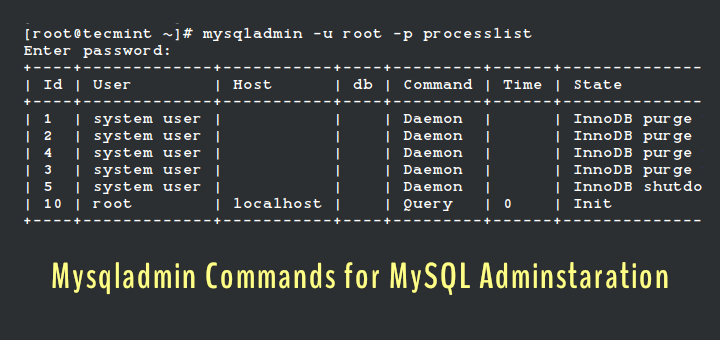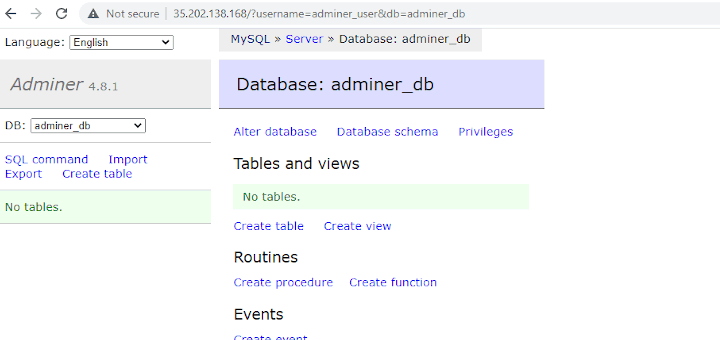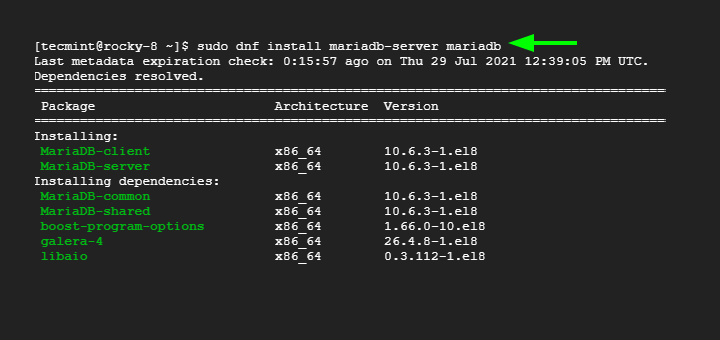This is the second part of a 2-article series about the essentials of MariaDB / MySQL commands. Please refer to our previous article on this topic before proceeding.
In this second part of MySQL/MariaDB beginner series, we will explain how to limit the number of rows returned by a SELECT query, and how to order the result set based on a given condition.
Additionally, we will learn how to group the records and perform basic mathematical manipulation on numeric fields. All of this will help us to create a SQL script that we can use to produce useful reports.
Prerequisites
To begin, please follow these steps:
1. Download the employees sample database, which includes six tables consisting of 4 million records in total.
# wget https://launchpad.net/test-db/employees-db-1/1.0.6/+download/employees_db-full-1.0.6.tar.bz2 # tar xjf employees_db-full-1.0.6.tar.bz2 # cd employees_db
2. Enter the MariaDB prompt and create a database named employees:
# mysql -u root -p Enter password: Welcome to the MariaDB monitor. Commands end with ; or \g. Your MariaDB connection id is 2 Server version: 10.1.14-MariaDB MariaDB Server Copyright (c) 2000, 2016, Oracle, MariaDB Corporation Ab and others. Type 'help;' or '\h' for help. Type '\c' to clear the current input statement. MariaDB [(none)]> CREATE DATABASE employees; Query OK, 1 row affected (0.00 sec)
3. Import it into your MariaDB server as follows:
MariaDB [(none)]> source employees.sql
Wait 1-2 minutes until the sample database is loaded (keep in mind we’re talking about 4M records here!).
4. Verify that the database was imported correctly by listing its tables:
MariaDB [employees]> USE employees; Database changed MariaDB [employees]> SHOW TABLES; +---------------------+ | Tables_in_employees | +---------------------+ | departments | | dept_emp | | dept_manager | | employees | | salaries | | titles | +---------------------+ 6 rows in set (0.02 sec)
5. Create a special account to use with the employees database (feel free to choose another account name and password):
MariaDB [employees]> CREATE USER empadmin@localhost IDENTIFIED BY 'empadminpass'; Query OK, 0 rows affected (0.03 sec) MariaDB [employees]> GRANT ALL PRIVILEGES ON employees.* to empadmin@localhost; Query OK, 0 rows affected (0.02 sec) MariaDB [employees]> FLUSH PRIVILEGES; Query OK, 0 rows affected (0.00 sec) MariaDB [employees]> exit Bye
Now login as empadmin user into Mariadb prompt.
# mysql -u empadmin -p Enter password: Welcome to the MariaDB monitor. Commands end with ; or \g. Your MariaDB connection id is 4 Server version: 10.1.14-MariaDB MariaDB Server Copyright (c) 2000, 2016, Oracle, MariaDB Corporation Ab and others. Type 'help;' or '\h' for help. Type '\c' to clear the current input statement. MariaDB [(none)]> USE employees; Reading table information for completion of table and column names You can turn off this feature to get a quicker startup with -A Database changed
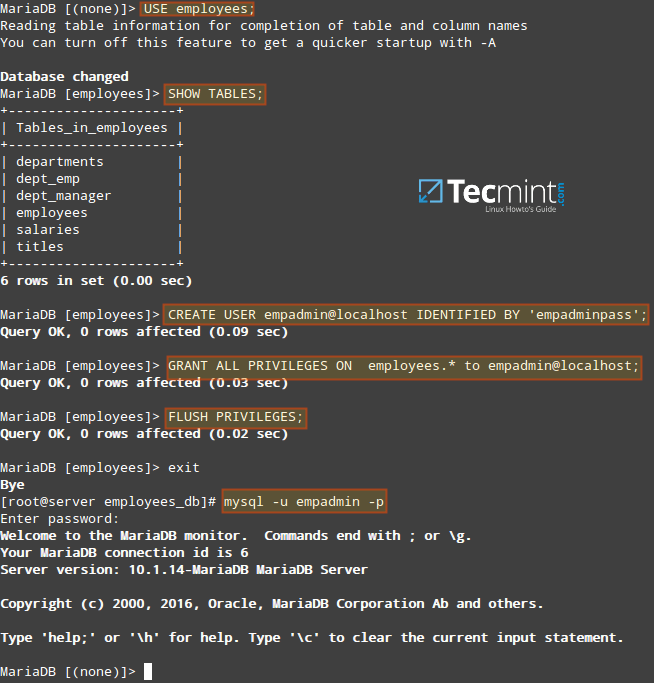
Make sure all of the steps outlined in the above image have been completed before proceeding.
Ordering and Limiting the Number of Rows in the Result Set
The salaries table contains all the incomes of each employee with start and end dates. We may wish to view the salaries of emp_no=10001 over time. This will help answer the following questions:
- Did he / she get any raises?
- If so, when?
Execute the following query to find out:
MariaDB [employees]> SELECT * FROM salaries WHERE emp_no=10001 ORDER BY from_date; +--------+--------+------------+------------+ | emp_no | salary | from_date | to_date | +--------+--------+------------+------------+ | 10001 | 60117 | 1986-06-26 | 1987-06-26 | | 10001 | 62102 | 1987-06-26 | 1988-06-25 | | 10001 | 66074 | 1988-06-25 | 1989-06-25 | | 10001 | 66596 | 1989-06-25 | 1990-06-25 | | 10001 | 66961 | 1990-06-25 | 1991-06-25 | | 10001 | 71046 | 1991-06-25 | 1992-06-24 | | 10001 | 74333 | 1992-06-24 | 1993-06-24 | | 10001 | 75286 | 1993-06-24 | 1994-06-24 | | 10001 | 75994 | 1994-06-24 | 1995-06-24 | | 10001 | 76884 | 1995-06-24 | 1996-06-23 | | 10001 | 80013 | 1996-06-23 | 1997-06-23 | | 10001 | 81025 | 1997-06-23 | 1998-06-23 | | 10001 | 81097 | 1998-06-23 | 1999-06-23 | | 10001 | 84917 | 1999-06-23 | 2000-06-22 | | 10001 | 85112 | 2000-06-22 | 2001-06-22 | | 10001 | 85097 | 2001-06-22 | 2002-06-22 | | 10001 | 88958 | 2002-06-22 | 9999-01-01 | +--------+--------+------------+------------+ 17 rows in set (0.03 sec)
Now what if we need to view the latest 5 raises? We can do ORDER BY from_date DESC. The DESC keyword indicates that we want to sort the result set in descending order.
Additionally, LIMIT 5 allows us to return only the top 5 rows in the result set:
MariaDB [employees]> SELECT * FROM salaries WHERE emp_no=10001 ORDER BY from_date DESC LIMIT 5; +--------+--------+------------+------------+ | emp_no | salary | from_date | to_date | +--------+--------+------------+------------+ | 10001 | 88958 | 2002-06-22 | 9999-01-01 | | 10001 | 85097 | 2001-06-22 | 2002-06-22 | | 10001 | 85112 | 2000-06-22 | 2001-06-22 | | 10001 | 84917 | 1999-06-23 | 2000-06-22 | | 10001 | 81097 | 1998-06-23 | 1999-06-23 | +--------+--------+------------+------------+ 5 rows in set (0.00 sec)

You can also use ORDER BY with multiple fields. For example, the following query will order the result set based on the employee’s birth date in ascending form (the default) and then by the last names in alphabetical descending form:
MariaDB [employees]> SELECT CONCAT(last_name, ', ', first_name) AS Name, gender AS Gender, hire_date AS "Hire date" FROM employees ORDER BY birth_date, last_name DESC LIMIT 10; +--------------------+--------+------------+ | Name | Gender | Hire date | +--------------------+--------+------------+ | Whitcomb, Kiyokazu | M | 1988-07-26 | | Schaad, Ronghao | M | 1988-07-10 | | Remmele, Supot | M | 1989-01-27 | | Pocchiola, Jouni | M | 1985-03-10 | | Kuzuoka, Eishiro | M | 1992-02-12 | | Decaestecker, Moni | M | 1986-10-06 | | Wiegley, Mircea | M | 1985-07-18 | | Vendrig, Sachar | M | 1985-11-04 | | Tsukuda, Cedric | F | 1993-12-12 | | Tischendorf, Percy | M | 1986-11-10 | +--------------------+--------+------------+ 10 rows in set (0.31 sec)

You can view more information about LIMIT here.
Grouping Records / MAX, MIN, AVG, and ROUND
As we mentioned earlier, the salaries table contains the incomes of each employee over time. Besides LIMIT, we can use the MAX and MIN keywords to determine when maximum and minimum number of employees were hired:
MariaDB [employees]> SELECT CONCAT(last_name, ', ', first_name) AS Name, MAX(B.salary) AS "Max. salary" FROM employees A JOIN salaries B ON A.emp_no = B.emp_no WHERE A.emp_no IN (10001, 10002, 10003) GROUP BY A.emp_no; +-----------------+-------------+ | Name | Max. salary | +-----------------+-------------+ | Facello, Georgi | 88958 | | Simmel, Bezalel | 72527 | | Bamford, Parto | 43699 | +-----------------+-------------+ 3 rows in set (0.02 sec) MariaDB [employees]> SELECT CONCAT(last_name, ', ', first_name) AS Name, MIN(B.salary) AS "Min. salary" FROM employees A JOIN salaries B ON A.emp_no = B.emp_no WHERE A.emp_no IN (10001, 10002, 10003) GROUP BY A.emp_no; +-----------------+-------------+ | Name | Min. salary | +-----------------+-------------+ | Facello, Georgi | 60117 | | Simmel, Bezalel | 65828 | | Bamford, Parto | 40006 | +-----------------+-------------+ 3 rows in set (0.00 sec)
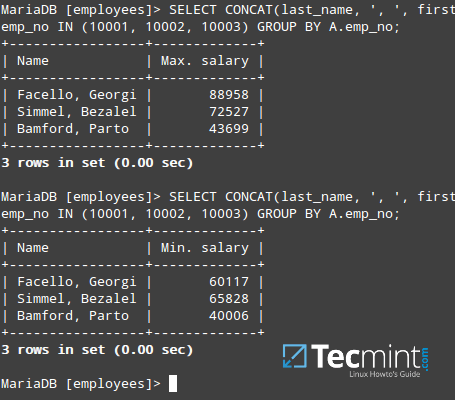
Based on the above result sets, can you guess what the below query will return?
MariaDB [employees]> SELECT CONCAT(last_name, ', ', first_name) AS Name, ROUND(AVG(B.salary), 2) AS "Avg. salary" FROM employees A JOIN salaries B ON A.emp_no = B.emp_no WHERE A.emp_no IN (10001, 10002, 10003) GROUP BY A.emp_no; +-----------------+-------------+ | Name | Avg. salary | +-----------------+-------------+ | Facello, Georgi | 75388.94 | | Simmel, Bezalel | 68854.50 | | Bamford, Parto | 43030.29 | +-----------------+-------------+ 3 rows in set (0.01 sec)
If you agree that it will return the average (as specified by AVG) salary over time rounded to 2 decimals (as indicated by ROUND), you’re right.
If we want to view the sum of the salaries grouped by employee and return the top 5, we can use the following query:
MariaDB [employees]> SELECT emp_no, SUM(salary) AS Salary FROM salaries GROUP BY emp_no ORDER BY Salary DESC LIMIT 5; +--------+---------+ | emp_no | Salary | +--------+---------+ | 109334 | 2553036 | | 43624 | 2492873 | | 66793 | 2383923 | | 237542 | 2381119 | | 47978 | 2374024 | +--------+---------+ 5 rows in set (2.22 sec)
In the above query, salaries are grouped by employee and then the sum is performed.
Bringing it all Together
Fortunately, we don’t need to run query after query to produce a report. Instead, we can create a script with a series of SQL commands to return all the necessary result sets.
Once we execute the script, it will return the required information without further intervention on our part. For example, let’s create a file named maxminavg.sql in the current working directory with the following contents:
--Select database USE employees; --Calculate maximum salaries SELECT CONCAT(last_name, ', ', first_name) AS Name, MAX(B.salary) AS "Max. salary" FROM employees A JOIN salaries B ON A.emp_no = B.emp_no WHERE A.emp_no IN (10001, 10002, 10003) GROUP BY A.emp_no; --Calculate minimum salaries SELECT CONCAT(last_name, ', ', first_name) AS Name, MIN(B.salary) AS "Min. salary" FROM employees A JOIN salaries B ON A.emp_no = B.emp_no WHERE A.emp_no IN (10001, 10002, 10003) GROUP BY A.emp_no; --Calculate averages, round to 2 decimal places SELECT CONCAT(last_name, ', ', first_name) AS Name, ROUND(AVG(B.salary), 2) AS "Avg. salary" FROM employees A JOIN salaries B ON A.emp_no = B.emp_no WHERE A.emp_no IN (10001, 10002, 10003) GROUP BY A.emp_no;
Lines beginning with two dashes are ignored, and the individual queries are executed one after another. We can execute this script either from the Linux command line:
# mysql -u empadmin -p < maxminavg.sql Enter password: Name Max. salary Facello, Georgi 88958 Simmel, Bezalel 72527 Bamford, Parto 43699 Name Min. salary Facello, Georgi 60117 Simmel, Bezalel 65828 Bamford, Parto 40006 Name Avg. salary Facello, Georgi 75388.94 Simmel, Bezalel 68854.50 Bamford, Parto 43030.29
or from the MariaDB prompt:
# mysql -u empadmin -p Enter password: Welcome to the MariaDB monitor. Commands end with ; or \g. Your MariaDB connection id is 4 Server version: 10.1.14-MariaDB MariaDB Server Copyright (c) 2000, 2016, Oracle, MariaDB Corporation Ab and others. Type 'help;' or '\h' for help. Type '\c' to clear the current input statement. MariaDB [(none)]> source maxminavg.sql Reading table information for completion of table and column names You can turn off this feature to get a quicker startup with -A Database changed
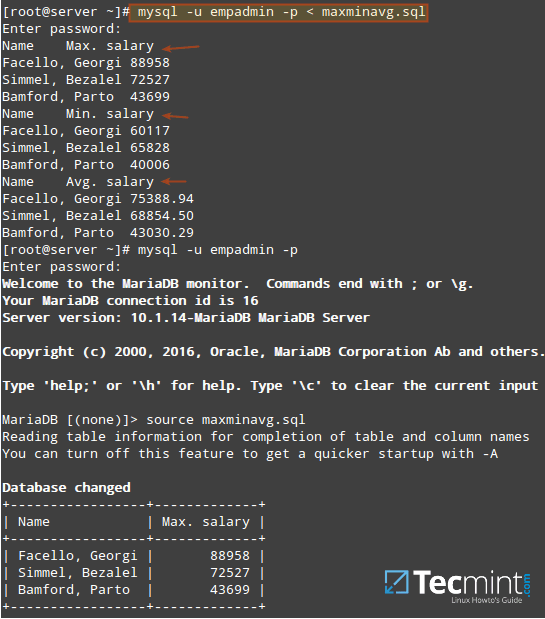
Summary
In this article we have explained how to use several MariaDB functions in order to refine result sets returned by SELECT statements. Once they have defined, multiple individual queries can be inserted in a script to execute it more easily and to reduce the risk of human error.
Do you have any questions or suggestions about this article? Feel free to drop us a note using the comment form below. We look forward to hearing from you!



